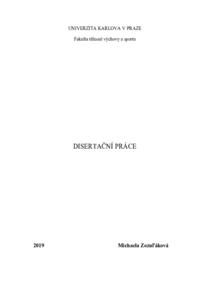Lezení u dětí a mládeže: akutní fyziologická odezva a využití lezení pro rozvoj síly na příkladu horních končetin
Climbing in children and youth: acute physiological responses to climbing and their implications for upper body strength.
dizertační práce (OBHÁJENO)

Zobrazit/
Trvalý odkaz
http://hdl.handle.net/20.500.11956/110928Identifikátory
SIS: 165514
Kolekce
- Kvalifikační práce [8824]
Autor
Vedoucí práce
Konzultant práce
Baláš, Jiří
Oponent práce
Nosek, Martin
Krobot, Alois
Fakulta / součást
Fakulta tělesné výchovy a sportu
Obor
-
Katedra / ústav / klinika
Laboratoř sportovní motoriky
Datum obhajoby
26. 9. 2019
Nakladatel
Univerzita Karlova, Fakulta tělesné výchovy a sportuJazyk
Čeština
Známka
Prospěl/a
Klíčová slova (česky)
děti a mládež, lezení, spotřeba kyslíku, energetická náročnost, energetický výdejKlíčová slova (anglicky)
children and youth, climbing, oxygen consumption, energy expenditure, energy costNázev: Lezení u dětí a mládeže: akutní fyziologická odezva a využití lezení pro rozvoj síly na příkladu horních končetin Cíle: Cílem práce bylo stanovit fyziologickou odezvu organismu během lezení v reálných podmínkách a zároveň posoudit vliv lezení na rozvoj síly na příkladu horních končetin u dětí a mládeže. Metody: Výzkumný soubor tvořilo 112 dětí ve věku 9,8 ± 1,4 let. Z toho u 91 dětí jsme zjišťovali vliv lezení na sílu horních končetin pomocí specifických lezeckých testů (výdrž ve shybu na hrazdě, výdrž ve visu na dřevěné liště a maximální sílu stisku ruky ručním dynamometrem). Všechny tři testy představují izolované měření svalových skupin, které se zapojují při lezeckém pohybu. U 21 dětí jsme zjišťovali akutní odezvu lezení pomocí metody nepřímé kalorimetrie. Energetická náročnost sloužila jako ukazatel lezecké dovednosti a energetický výdej byl použit k vyjádření celkové lezecké práce. Studie trvala 16 týdnů a během této doby děti podstoupily tři měření. Na každé hodině instruktoři zaznamenávali vylezené cesty a jejich obtížnost. Délka studie odpovídala době trvání lezeckého kurzu během školního roku. Pro analýzu výsledků akutní fyziologické odezvy organismu u dětí při lezení jsme použili opakovanou analýzu rozptylu (rANOVA) a pro hodnocení specifických lezeckých testů jsme použili...
Title: Climbing in children and youth: acute physiological responses to climbing and their implications for upper body strength. Objectives: The aim of this thesis was to determine the physiological responses of children and youth to climbing and its implications for upper body strength. Methods: One hundred and twelve children (aged 9,8 ± 1,4 years) participated across two studies. Study one (91 children) explored the effects of climbing on upper body strength, with the aid of a battery of climbing specific tests (bent arm hang on the trapeze, finger hang on the wooden bar and maximal hand grip with the manual dynamometer). These tests were designed for the measurement of the key muscle groups involved in climbing. Study two (21 children) assessed acute physiological response to climbing using the indirect calorimetry method. Energy expenditure was used as an indicator of the climbing skills and to express the total climbing work completed. Study two lasted for 16 weeks, during this time the children underwent three measurements. Instructors recorded the routes climbed and their difficulty during each session. The period of the study corresponded with the duration of the climbing course for children during the school year. The results of the acute physiological response of children during climbing...
